Low Touch OMS와 ZeroAOS
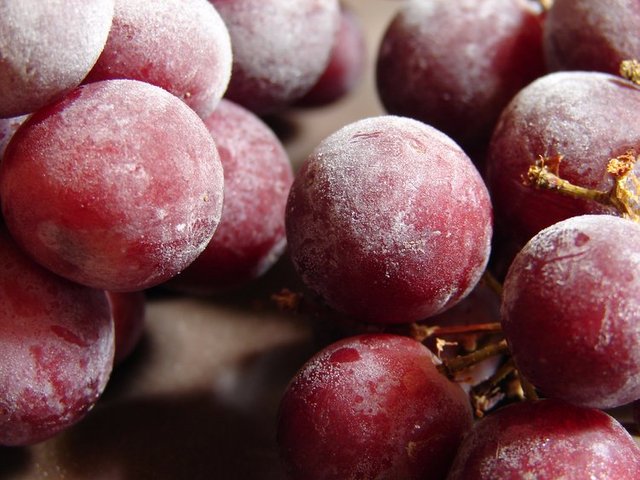
1.
High Touch, Low Touch. 익숙한 표현인가요? FIX를 처음 공부하기 시작하였던 2001년 Touch와 비슷한 개념을 접했습니다. FIX는 팩스로 주문 지시를 하고 이를 받아서 증권회사가 입력해서 실행하고 결과를 팩스 등으로 보내는 업무흐름을 전자적인 방식으로 바꾸었고 Human Intervention을 줄이는 목적이었죠. 요즘은 거의 사용하지 않는 STP(Straight Through Processing)입니다. 지금으로 이야기하면 FIX이전과 이후를 비교하면 High Touch와 Low Touch로 나눌 수 있습니다.Quora에 올라온 High Touch에 관한 답변입니다.
High Touch is a business model that requires above average interaction with customers, versus low touch where interaction is minimal and transactional.Think McDonald's drive through as low-touch: place your order over a microphone, pull up, swipe your card and get your food. High touch would be a restaurant where the waiter introduces himself or herself, talks about the guest's evening, recommends some meals, then offers wine pairings based o their meal choices.
그러면 High와 Low의 기준은 하나일까요? Buy Side와 Sell Side 그리고 거래소를 놓고 보면 사람이 개입할 곳은 여럿입니다. 한국처럼 주문흐름이 단일한 시장이 아닌 미국이나 유럽의 경우 Dealer의 개입이 있고 없음에 따라 High와 Low를 나눌 수 있습니다. Broker-Dealer인 중개사가 주문을 받아서 내부 딜러에게 주문집행을 요청할 수 있기때문이죠. 예를 들어 아래의 자료는 다음과 같은 의미로 High/Low Touch를 정의합니다. Order Flow를 기준으로 정의합니다. 2014년과 2015년 Sales Trader를 주제로 Greenwich Associates가 발표한 보고서들입니다. Sales Trader의 환경이 어떻게 변화하고 있는지를 보여줍니다. 한국에서는 성립할 수 없는 정의이고 비즈니스입니다.
While high-touch and low-touch are common industry terms, how they are defined can vary considerably. Greenwich Associates uses the following definitions in our research and analysis: • High-Touch: Single-stock trades sent to broker sales traders, communicated either by phone, messaging, email, or FIX protocol. • Low-Touch: Electronic single-stock trades using algorithms including dark pool sourcing algos or DMA/smart-order routing trades and/or electronic single-stock trades that are sent to crossing networks.
[gview file="http://smallake.kr/wp-content/uploads/2019/04/GA-Sales-Trader-Future-Report.pdf"]
[gview file="http://smallake.kr/wp-content/uploads/2019/04/93421_TheFutureSalesTrader.pdf"]
이상과 같은 변화를 이끌어낸 동력은 핵심적으로는 주식시장의 전자화입니다. HFT, DMA 및 Naked Access가 퍼지기 시작할 때입니다. 이런 배경으로 OMS와 관련한 시장의 요구가 변화하고 있습니다. 2016년에 쓰여진 Key to the Highway: The Changing Face of High and Low Touch Execution은 다음과 같이 High/Low Touch Trading의 변화를 설명하고 있습니다.
In the beginning, there was high touch where brokers provided a high-value, solution-based approach to finding the liquidity their buy-side clients were looking for. This worked in an era of high fees and low scrutiny of what end-investor trading commissions were actually funding. However, as markets electronified, and buy-side operations tooled up, a new paradigm was born: low touch. This reflected the buy-side’s growing desire for cheaper execution, especially for trades that weren’t that hard to execute, and it also offered a path that minimised information leakage.The result? Two routes to market with very different price tags. The problem was that brokers had to duplicate their trading infrastructure despite receiving fewer net commission dollars. This spawned the short-lived concept of mid touch which offered the worst of both worlds: junior sales traders with neither the experience nor the expertise to manage either. And so the industry muddled along ignoring the operational overhead of running two technology stacks.
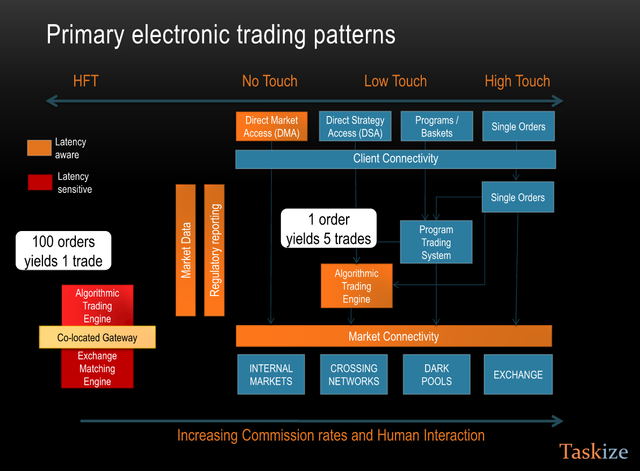
최근 FIXGlobal에 올라온 글은 Low/High Touch가 어떻게 변화하고 있는지를 확인할 수 있습니다. 그중에서 High Touch Algos은 자동화(Automation)을 강조합니다.
However, the traditional “low touch” service approach is no longer an option when the goal is to achieve the highest possible ranking on a client’s execution performance scorecard. Automation and investment in trade process technology create efficiencies that support the sell-side’s efforts to provide clients with “high touch” services at “low touch” rates, together with all the block liquidity access, service guarantees and analytics clients expect from their customized service partnerships.AUTOMATION AND TECHNOLOGY
Trade process automation starts with the order and execution management system (OEMS).A robust application with the ability to process large amounts of order and execution data across global markets with speed and efficiency is no longer enough.
Increasingly, sell-side OEMS systems are being assigned tasks that were previously done manually by sales traders. Performance monitoring and alert functionalities are continually being built into OEMS applications to automate streamlined procedures in an effort to help sales traders stay ahead of the curve with proactive status updates and client notifications relating to suspicious order or execution messages. The OEMS build-out is a reflection of a firm’s attention to detail and is a testament to the collaborative efforts between the sales trading team and the product development team.
Equities trading : High and low-touch trading은 고객의 특성 - 주문빈도 및 트레이더의 개입정도 - 에 따라서 선택적으로 서비스를 받을 수 있도록 High/Low을 통합하는 서비스를 주장합니다.
Forget high-& low-touch – in 2018, the focus is ‘how-touch’There is little that universally differentiates bank high- and low-touch workflows in different regions and with different client types. Instead of set service offerings and workflows that are broadly applicable across many different types of equities trading banks, how bank traders interact with client orders is very situational and can take a wide range of forms.
Indeed, with the exception of DMA / SMA clients that send their orders directly to the bank EMS – often a separate ultra-low latency system, reserved exclusively for these clients – all orders take the same path and can be interacted with at the same points.
The difference between high- and low-touch traders in 2018 is the frequency and level of interaction with the orders, and therefore value-add, they are expected to have at different points in the trading lifecycle. High-touch traders are expected to review and, if necessary, bring their market knowledge to bear on client orders before they pass from the bank’s OMS to its EMS. Both high- and low-touch clients expect any electronic or algorithmic execution to be monitored in real time. Indeed, more technologically sophisticated clients may even demand that information about execution is streamed back to their buyside OMS or PMS during the execution process.
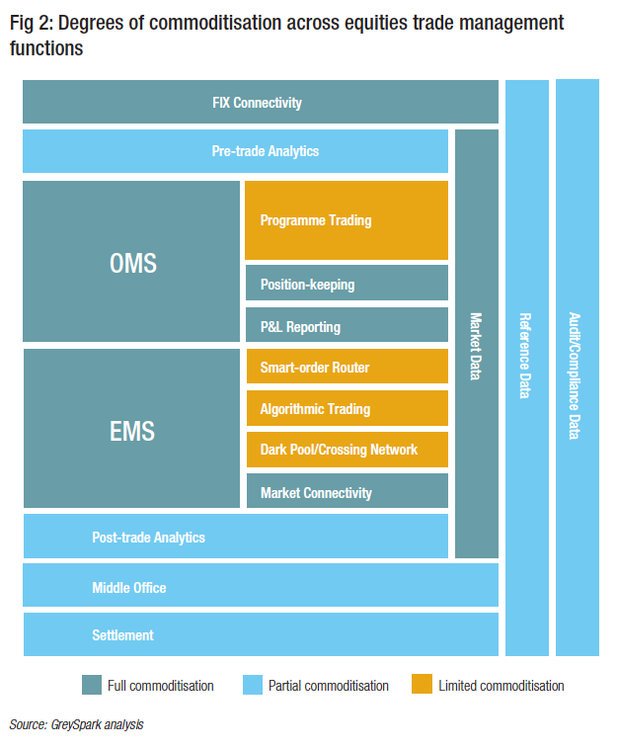
앞서 frequency와 level of interaction with the orders를 기준으로 보면 한국 증권회사들이 제공하는 서비스는 High Touch OEMS입니다. 어떤 방향의 서비스로 진화하여야 할까요? 이 질문과 유사한 토론이 있었습니다. Low Touch Trading - The Transition from Algos to Service이 소개한 질문입니다. 질문은 아래와 같습니다. 최우선 순위는 'Customized'입니다. 예를 들어 VWAP이라고 하더라도 나에게 적합한 알고리즘을 사용할 수 있는 환경을 제공해달라는 요구입니다.
Question: What is the most important factor the Sell Side provides the Buy Side with respect to their Electronic Trading service through an OMS/EMS platform?

The Low Touch (R)evolution는 Greenwich Associates의 보고서를 인용하여 다음과 같은 요구를 소개합니다.
The simple fact is this: The buy side, whether from want, or need is becoming more involved with how their brokers are executing their orders. Regulation like MiFID II's unbundling of execution from research, and the wake-up call delivered by Michael Lewis' Flash Boys has meant that no longer can the 'how' of execution be ignored. The broker's algo suite has moved from a commoditized tool box that often times was simply a white-labeled version of another broker's offering, to the new battleground broker's use to compete for business. This shiny new thing has taken the form of customization, or to quote Greenwich, the 'ability to say "yes" to their client's request'.
어떻게 Customization 요구에 부응할까요? 아래와 같은 제안을 합니다. Order Handling Workflow Layer입니다.
Bringing a layer of order handling workflow into the Low Touch OMS brings with it an ability to think of the algos as building blocks at your disposal and truly define your own service – whether solely using another's algos, or supplementing your service to fill coverage gaps, delivering a seamless service to your clients.
해외와 한국의 규제환경이 다르기때문에 시스템의 변화를 단순히 적용할 수 없습니다. 그럼에도 기관투자자의 요구가 시스템의 변화에 어떤 영향을 주었는지를 염두해두면 좋을 듯 합니다. 한국의 기관투자가환경을 보죠. 일반적으로 FIX를 도입하면 Buy Side와 Sell Side는 FIX를 이용하여 주문지시와 체결결과등을 주고받습니다. CD주문을 많이 이용하고 CD주문을 처리하기 위하여 Sell Side의 트레이더는 VWAP이나 TWAP과 같은 적용한 OMS로 주문을 처리하거나 코스콤 K-Front 화면과 같은 단말을 이용하여 주문을 처리합니다. 해외의 Sales Trader나 Algo Desk와 비슷합니다.
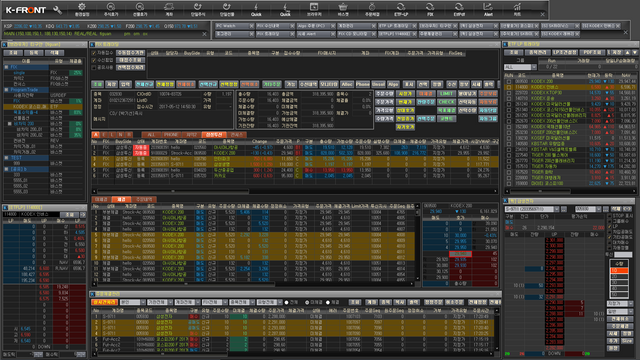
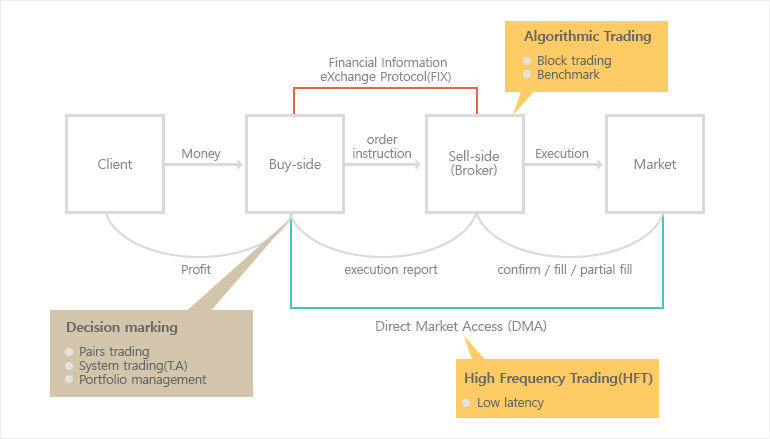
ZeorAOS를 구상하던 때도 2010년쯤입니다. DMA가 보편화하고 고빈도매매가 유행처럼 번지던 때입니다. ZeroAOS는 단순히 DMA를 이용하여 매매를 하고자 하는 트레이더를 위한 상품이자 서비스였습니다. 이후 10년 시장은 많이 바뀌었습니다. 파생상품시장이나 ELW시장은 규제로 거래량이 대폭 줄었고 HFT를 무기로 외국인투자자들이 대거 시장에 진입하면서 그들만의 시장으로 바뀌었습니다. ZeroAOS를 이용하는 주고객도 자동매매에 관심을 가지는 금융회사의 프랍팀으로 바뀌었습니다. 몇 년 데이타를 기반으로 하는 플랫폼이나 로보어드바이저와 같은 자산관리서비스로 변화도 모색해 보았지만 제품화나 상품성이 걸림돌이었습니다. ZeroAOS는 2002년 FIX를 위한 HiperFIX를 만들고 Buy/Sell Side OMS를 시장에 내놓은 경험과 다른 길이라고 생각했습니다. 그런데 이상과 같은 정리를 해보니까 ZeroAOS는 과거에 개발하였던 HiperOMS의 연장선에 있는 제품이라는 생각이 들었습니다. 영화 '봄날은 간다'의 '어떻게 사랑이 변하니?'라고 할 수 있지만 FIX가 보편화한 이후 DMA등이 매매환경을 바꾸어놓았기때문입니다.
ZeroAOS로 Low Touch OMS가 가능한 이유입니다.
첫째 전략컨테이너(Strategy Container)개념을 적용했고 이를 통하여 투자자별로 독립된 전략운용이 가능하도록 하였습니다. 똑같은 VWAP이나 TWAP이라고 하더라도 고객의 요구에 따라 수정하여 독립적으로 운영할 수 있습니다.
둘째 전략개발도 제공하는 API를 이용하여 개발할 수 있고 복수의 전략도 운용할 수 있습니다.
셋째 전략을 관리할 때 패러매터를 기준으로 합니다. 전략의 특성에 맞게끔 사전에 정의한 패러매터를 실시간으로 변경하면서 운용가능합니다. 이를 FIX 전문화하면 Buy Side도 직접 전략을 관리할 수 있습니다. 2000년대 후반 FIX Community는 FIXatdl을 통하여 이와 비슷한 표준을 제정하였습니다. 전략 및 화면에 대한 정의까지를 포괄하지만 광범위하게 사용하지 않고 있습니다.
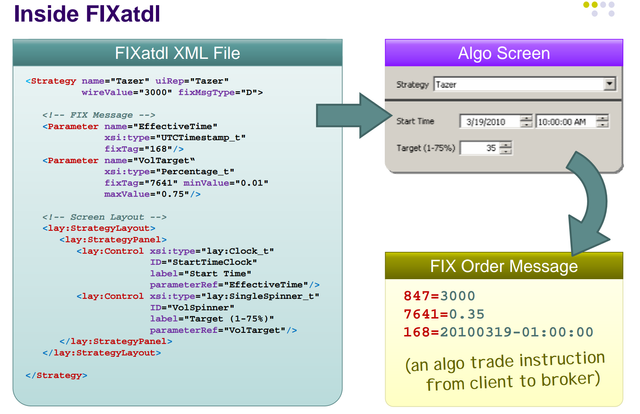
ZeroAOS를 FIX/OMS에 적용하면 어떤 모양일까요? 아래입니다. 참고로 ZeroFIX라는 Low Latency FIX Engine도 제공가능합니다. 코스콤 STP-Hub에서 운용중입니다.
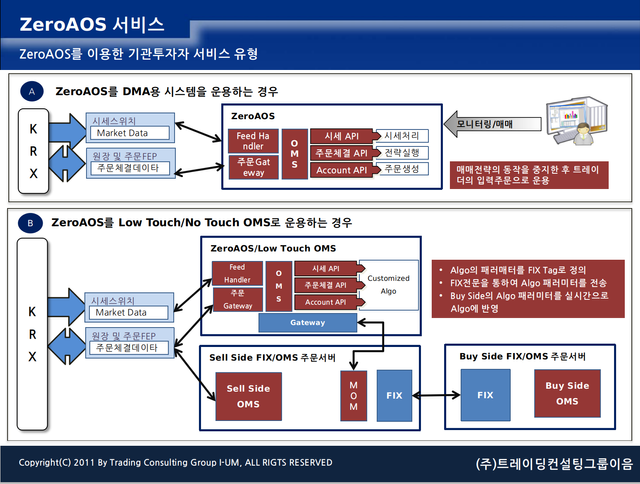
Posted from my blog with SteemPress : http://smallake.kr/?p=26828
Congratulations @smallake! You have completed the following achievement on the Steem blockchain and have been rewarded with new badge(s) :
You can view your badges on your Steem Board and compare to others on the Steem Ranking
If you no longer want to receive notifications, reply to this comment with the word
STOPVote for @Steemitboard as a witness to get one more award and increased upvotes!